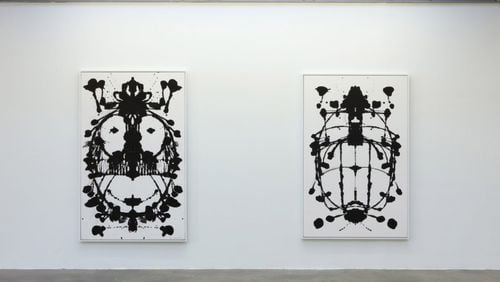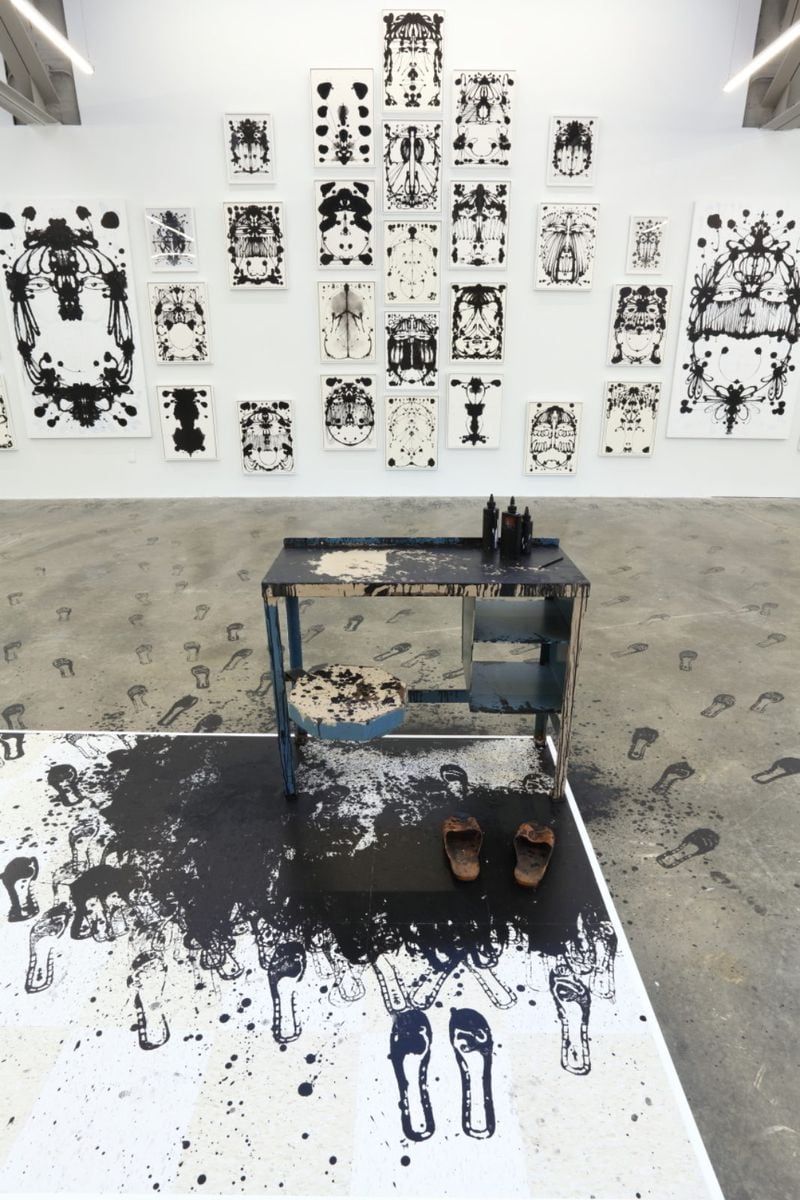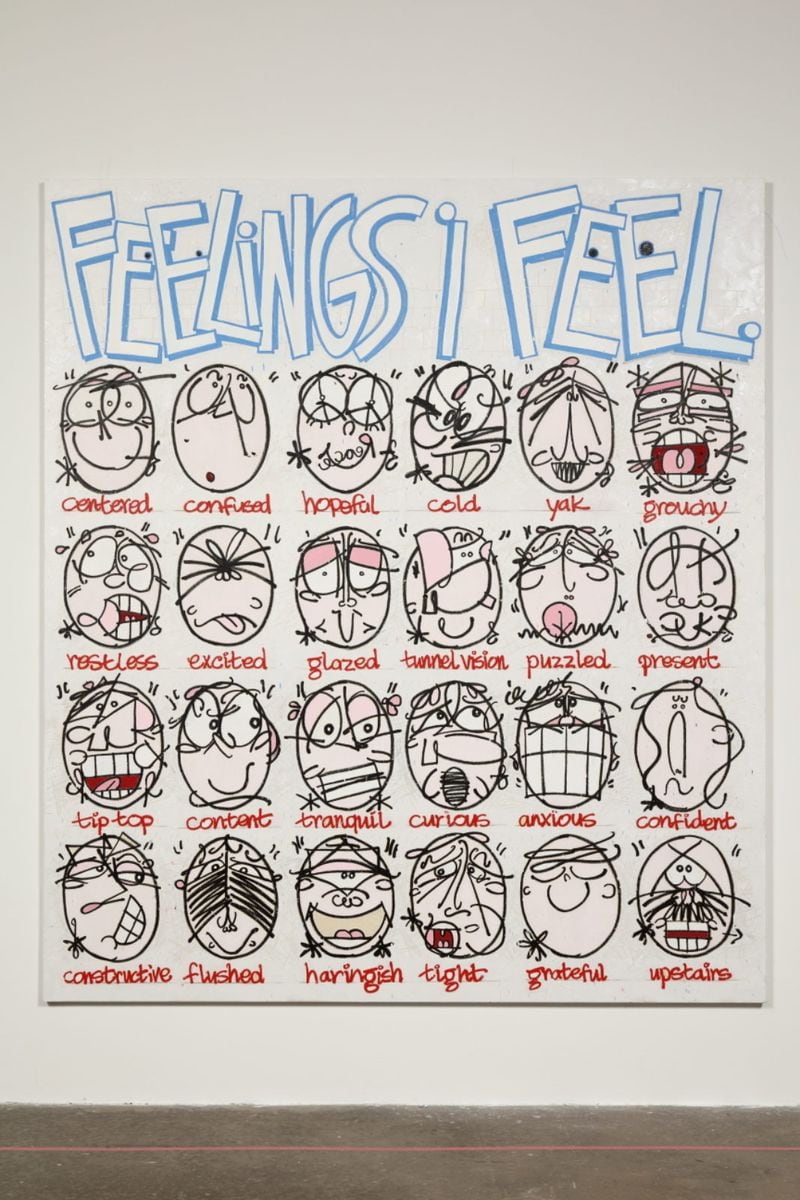This story was originally published by ArtsATL.
Timothy Curtis’ exhibit at Atlanta Contemporary uses one of society’s most recognizable tools of psychoanalysis to share his journey of embracing his feelings while challenging others to do the same.
”Inkblots and Feelings Charts,” on view through May 19, centers Rorschach inkblot tests — a century-old device initially used to diagnose schizophrenia and, later, general personality projection — as useful tools in his own emotional reckoning behind bars.
Small groupings of inkblots accent the edges of the exhibit. In the center of the room is a small, well-worn desk awash with ink that flows down to the tiled platform on which the desk stands, with a pair of sandals underneath. Inky footprints from the desk lead to the centerpiece of the exhibit, a sprawling collection of unconventional black and white inkblots that form their own type of congruent blot in the way that they are arranged.
Credit: Courtesy of Atlanta Contemporary
Credit: Courtesy of Atlanta Contemporary
A pair of large-scale paintings — the feelings charts — also ask viewers to confront their own feelings. Curtis’ whimsical graffiti hand is very present in “How You Feeling?,” the first chart in a series of facial expressions, each accompanied by a defining word, where “energized” could easily be “frazzled,” and “optimistic” still hints at the feeling of worry. “Feelings I Feel,” the second chart, is a wall of pseudo self-portraits, showing the many moods of the artist, with words like “yak” and “upstairs,” perhaps for the times when feelings are hard to explain.
The charts are a mirror in some ways, the tiniest details of the facial expressions evoking a memory within viewers that helps them attach to the feeling expressed. The exhibit is a reminder of the universality of feelings and the need for compassion: If they can see themselves in the expressions of these comic-like faces, surely they can do so when the reflection — the humanity of a stranger — matches their own.
In many ways, the exhibit demonstrates the harmony of contradictions, from the footprints that are at once distinctively a pair of bare feet and the sole of the sandals to the complexity, depth and unevenness of emotions being captured in the simplicity and symmetry of black and white.
Curtis’ life story is a beautiful contradiction itself.
Conceived between 2009 and 2014, during Curtis’ time in federal prison, “Inkblots and Feelings Charts” is a powerful representation of the talent trapped in confinement. A self-taught artist, Curtis began to study art history there. He also began to face his feelings. The exhibit encapsulates parts of that experience — a photo of himself in his cell, mail from his daughter, his other resourceful creations, research on Rorschach tests, journals, documents of books he’d ordered — showing his yearning for growth beyond a troubling circumstance. And there are notebooks full of his inkblot art, works numbering into the tens of thousands. They reflect his infinitely evolving state of emotions.
Credit: Courtesy of Atlanta Contemporary
Credit: Courtesy of Atlanta Contemporary
Art was Curtis’ mental escape in prison, as well as a way to counsel others. He spearheaded the creation of a mural painting group of artists who were all facing life sentences, bringing color and joy to a gray and depressive atmosphere.
Now with a studio in New York City and shows from Atlanta to Tokyo to Málaga, Spain — the birthplace of Pablo Picasso, whose cubist and modernist influence seeps into some of Curtis’ acrylic and oil paintings — Curtis is miles away from tagging walls around his native Philadelphia as he did from the age of 9.
Without his background at the forefront of the exhibit, though, “Inkblots and Feelings Charts” is simply an interpretation of Rorschach tests, falling in line with their ubiquitous presence in popular culture. They are crisp and well done but a shadow of his other works and styles.
His signature animated faces are elevated in his 2023 Paris show, ”Self-Watering Flowers,” each framed by gorgeous cobalt blue florals that leap from the canvas. And even with a consistent palette of mostly deep-hued primary colors, Curtis’ other paintings and screenprints offer an exhilaration that can be difficult to summon with black and white.
Regardless, “Inkblots and Feelings Charts” is a lesson in perception and perspective; everything can change depending on the beholder’s eyes.
ART REVIEW
“Inkblots and Feelings Charts”
Through May 19 at Atlanta Contemporary. Free. Noon-4 p.m. Sundays; noon-5 p.m. Tuesdays-Wednesdays and Friday-Saturdays; noon-8 p.m. Thursdays. 535 Means St. NW, Atlanta. 404-688-1970, atlantacontemporary.org
Credit: ArtsATL
Credit: ArtsATL
MEET OUR PARTNER
ArtsATL (artsatl.org) is a nonprofit organization that plays a critical role in educating and informing audiences about metro Atlanta’s arts and culture. ArtsATL, founded in 2009, helps build a sustainable arts community contributing to the economic and cultural health of the city.
If you have any questions about this partnership or others, please contact Senior Manager of Partnerships Nicole Williams at nicole.williams@ajc.com.
About the Author









